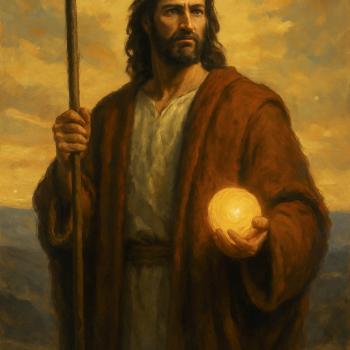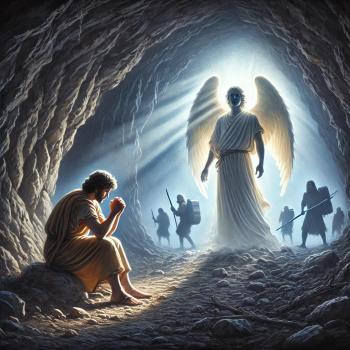Revelation 4:1-11 The Seven Wonders of Worship in Heaven
You may have heard of the seven wonders of the ancient world. The historian Herodotus (484 – ca. 425 BCE), and the scholar Callimachus of Cyrene (ca. 305 – 240 BCE) at the Museum ofAlexandria, made early lists of seven wonders. Their writings have not survived, except as references.
The classic seven wonders were:
- Great Pyramid of Giza
- Hanging Gardens of Babylon
- Statue of Zeus at Olympia
- Temple of Artemis at Ephesus
- Mausoleum at Halicarnassus
- Colossus of Rhodes
- Lighthouse of Alexandria
The only ancient world wonder that still exists is the Great Pyramid of Giza.1
Here in Revelation 4:1-11, we see the seven wonders of worship in Heaven. These wonders were shown to John by the Holy Spirit. Let’s look at these wonders and see how these wonders encourage our worship. Scholars have read in various ways the section of Revelation following the letters to the churches.12 But most likely chapters 4–5 introduce the heavenly events that precede and explain the seals, trumpets, and vials of chapters 6–16; events in heaven affect and are affected by events on earth (12:7–12).3
SEVEN WONDERS OF WORSHIP IN HEAVEN4
- The throne (Revelation 4:2)
The key word in this chapter is throne;it is used fourteen times. In fact, this is a key word in the entire book, appearing forty-six times.5 The throne is a place of submission. Everything and everyone submits to the throne. God sits on the throne. The rainbow is around the throne. The 24 elders are before the throne. The thunder, lightning comes out from the throne. The throne is the centerpiece of the worship in Heaven.
- The One (Revelation 4:3)
The One who sits on the throne is the center of attention. The One is our audience. The One is God the Father. He rules and reigns from Heaven. All of the activity in Heaven centers upon Him. His will is done in Heaven because He rules Heaven.
- The rainbow (Revelation 4:3)
The rainbow is God’s glory, which is what we behold.
The “rainbow” (4:3) recalls the radiance of God’s throne in Ezekiel 1:28. “Jasper” (4:3) was also crystal clear and brilliant, so John’s audience will later recognize the new Jerusalem as the place of his glorious dwelling (21:11, 18–20); in Ezekiel God’s throne appeared like sapphire (Ezek. 1:26; 10:1)6
Judgment is about to fall, but the rainbow reminds us that God is merciful, even when He judges (Hab. 3:2). Usually, a rainbow appears after the storm; but here, we see it before the storm7
- The 24 elders (Revelation 4:4)
Who are these twenty-four elders seated on thrones? It is unlikely that they are angels, because angels are not numbered (Heb. 12:22), crowned, or enthroned. Besides, in Revelation 7:11, the elders are distinguished from the angels (see also Rev. 5:8–11). The crowns they wear are the “victor’s crowns” (the Greek word stephanos; see Rev. 2:10); and we have no evidence that angels receive rewards.8
The 24 elders are people we emulate. Some scholars suggest that they represent all of God’s people in Heaven.
The twenty-four elders around the throne (4:4), like other worshipers in heaven (4:7–9; 5:11–14), illustrate the appropriate response to God’s glory: worship (4:10–11; 5:8–10, 14).15910
Most important, however, the thunders and lightnings around the throne recall the revelation of God’s majesty when he gave the law at Mount Sinai (Ex. 19:16; 20:18).241112
- The seven fiery torches (Revelation 4:5)
Some state that the torches represent the Holy Spirit – Who illuminates our way. We follow His leadership in worship. We worship in spirit and truth. The fire of tongues fell on the apostles and they spoke in different languages. The fire led the people of Israel at night as they traveled for forty years in the desert.
At the same time, the seven lamps of fire, which Jesus has identified as the churches which were on the earth in chapter one, are now before the throne in chapter four13
- The sea of glass (Revelation 4:6)
Some scholars state that the sea belongs to the old creation and that it is a symbol for a test of evil.
The sea of glass, clear as crystal has been interpreted in conflicting ways. In that John ties it to the throne, the sea is another symbol of God’s reign. Within Revelation, the sea, like the heaven in which it is found, belongs to the old and not the new creation (21:1). It is the location of evil (13:1; cf. Psalm 74:12–14; Isaiah 51:9–10), through which God’s people must pass on their new Exodus to the promised land, the kingdom of God (15:1–3; cf. Exodus 14:21). In finding the sea in this vision of God’s heavenly throne, and by not finding it in John’s concluding vision of the new Jerusalem, the reader is made more aware that the destiny of the old order, including evil and death, is an ingredient of God’s plan.14
However, other scholars disagree. For example, Craig Keener states that the blue of the sea on Earth matches the blue of the sea in Heaven.
That the sea is of “glass, clear as crystal” reflects the sapphire that was “clear” in God’s revelation to Israel at Sinai (Exodus 24:10), but especially the crystalline, heavenly expanse beneath God’s throne and above the throne angels in Ezekiel 1:22. That it is like “crystal” links it with the new Jerusalem, clear enough for God’s great glory to shine through it (Revelation 21:11, 18, 21). It is thus probably not a symbol of subdued cosmic evil, as some commentators have suggested.2715 That the glass was “clear” contrasts with most of the glass available in John’s day.2816
Still others, like Chuck Missler, make the connection between the temple in Heaven and the laver or wash basin in the Jewish temple. He compares the sea to the Word of God, the Bible.
“The Elders are standing on the sea of glass, which seems to correlate with the “molten sea,” the laver in the Tabernacle and in the Temple. It represents the Word of God: when we were on the earth, we washed in it (Ephesians 5:26); here, the saints are standing on it.”17
Before the throne—lamps and a sea (vv. 5b–6a). The seven lamps connote completeness and symbolize the Holy Spirit of God (Revelation 1:4; note also Ezekiel 1:13). John also seems to suggest in Revelation that the “heavenly sanctuary” follows the pattern of the earthly tabernacle and temple (see Hebrews 9:23). The parallels are as follows:
|
Earthly temple |
Heavenly sanctuary |
|
Holy of holies |
The throne of God |
|
Seven-branched candlestick |
Seven lamps of fire before the throne |
|
Bronze laver |
Sea of glass |
|
Cherubin over the mercy seat |
Four living creatures around the throne |
|
Priests |
Elders (kings and priests) |
|
Brazen altar |
Altar (Rev. 6:9–11) |
|
Incense altar |
Incense Altar (Rev. 8:3–5) |
|
Ark of the covenant |
Ark of the covenant (Rev. 11:19) |
There is no temple in heaven in a material sense. All of heaven is God’s sanctuary for those who serve before His holy throne (Revelation 7:15). However, John indicates in Revelation 15:5–8 that there is a special “sanctuary” of God (note also Revelation 11:19). In the eternal state, there will be no temple (Revelation 21:22).18
- The four living creatures (Revelation 4:6-8)
The four living creatures remind us of our need to worship and praise God.
Drawing upon images found in the theophanies of Ezekiel 1 and Isaiah 6, John describes a group of four angelic beings he sees in the center, around the throne. As in Ezekiel’s vision of the cherubim (Ezekiel 1:6, 10), these four living creatures have the likenesses of a lion … an ox … the face of a man … a flying eagle, and are covered with eyes, in front and in back—an image of God’s omniscience. Their six wings correspond to Isaiah’s vision of the seraphs as well, which flew above God’s throne (cf. Isaiah 6:1–2).19
Each of the seven wonders in Heaven are wonders not because they are magnificent in and among themselves. These seven wonders are wonders because they are involved in worship (Revelation 4:8-11). Each of these seven wonders of worship teach us something about God and worship of God. John is lifted up by the Holy Spirit to a door which reveals Heaven to John (Revelation 4:1). So John walks through the door to see something from Heaven. Only John walks through the door. He is allowed to see this set of seven wonders in Heaven.
Everything in Heaven is the original blueprint for what should happen on Earth. What we do here is an earthly copy of what God intends. What is practiced in Heaven should happen on Earth with His people. As a result, we can see an application for everything that happens in worship. Each of these parts in Heaven fulfill a purpose – a purpose of worship which we can also participate.
1 Wikipedia, “Seven Wonders of the Ancient World,” Internet, https://en.wikipedia.org/wiki/Wonders_of_the_World, accessed on 16 January 2016.
21 Corsini, Apocalypse, 120–21, reads Rev. 4:1–8:1 as an allegory of salvation history beginning with the fall; André Feuillet, Johannine Studies, tr. Thomas E. Crane (Staten Island, N.Y.: Alba House, 1964), 256, suggests that Rev. 4–11 explains the Synoptic Apocalypse, starting with a.d. 70.
3 Craig S. Keener, Revelation, The NIV Application Commentary (Grand Rapids, MI: Zondervan Publishing House, 1999), 169.
4 Jim Erwin, “The Seven Wonders of Worship in Heaven,” Simple Thoughts Reflections 2016, Logos Bible Software Notes, 15 January 2016.
5 Warren W. Wiersbe, The Bible Exposition Commentary, vol. 2 (Wheaton, IL: Victor Books, 1996), 582.
6 Craig S. Keener, Revelation, The NIV Application Commentary (Grand Rapids, MI: Zondervan Publishing House, 1999), 171.
7 Warren W. Wiersbe, The Bible Exposition Commentary, vol. 2 (Wheaton, IL: Victor Books, 1996), 582.
8 Warren W. Wiersbe, The Bible Exposition Commentary, vol. 2 (Wheaton, IL: Victor Books, 1996), 582.
915 They surround the throne like a royal court (some also cite the tradition of the Sanhedrin—Bowman, First Christian Drama, 43), but also like a Greek chorus (cf. Callimachus, Hymn 4.301; 4 Macc. 8:4; 13:8; 14:7–8; they could have 24 members), whose function as a composite, usually reliable character they perform here. In Jewish visions both angels (T. Abr. 7 A) and martyrs (4 Macc. 17:18–19) could stand by God’s throne.
10 Craig S. Keener, Revelation, The NIV Application Commentary (Grand Rapids, MI: Zondervan Publishing House, 1999), 171.
1124 This continued to be emphasized in Jewish (Josephus, Ant. 3.80; Ps-Philo 11:4–5) and Samaritan (John Bowman, ed., Samaritan Documents Relating to Their History, Religion & Life, POTTS 2 [Pittsburgh, Pa.: Pickwick, 1977], 48) tradition. Cf. also the stormy revelation in Ezek. 1:4, 13.
12 Craig S. Keener, Revelation, The NIV Application Commentary (Grand Rapids, MI: Zondervan Publishing House, 1999), 173.
13 Chuck Missler, Learn the Bible in 24 Hours® (Nashville: Thomas Nelson, 2002).
14 Robert W. Wall, Revelation, Understanding the Bible Commentary Series (Grand Rapids, MI: Baker Books, 2011), 94.
1527 Michaels, Revelation, 92–93; against Caird, Commentary on Revelation, 65–68 (despite 13:1; 21:1). Crystal stones or apparatus appears in heaven, e.g., in 1 Enoch 71:5; T. Abr. 12 A. Exodus’s sapphire probably reflects the transparent blue of heaven (with b. Men. 43b, bar.); later teachers (rightly) linked the blue of the sea with the blue of heaven (Sifre Num. 115.2.8).
28 Cf. James Moffatt, The First Epistle of Paul to the Corinthians, MNTC (London: Hodder & Stoughton, 1938), 201. On the rare use of glass windows, see S. Safrai, “Home and Family,” 728–92 in JPFC, 734; M. Cary and T. J. Haarhoff, Life and Thought in the Greek and Roman World, 4th ed. (London: Methuen, 1946), 101, 116.
16 Craig S. Keener, Revelation, The NIV Application Commentary (Grand Rapids, MI: Zondervan Publishing House, 1999), 173–174.
17 Chuck Missler, Learn the Bible in 24 Hours® (Nashville: Thomas Nelson, 2002).
18 Warren W. Wiersbe, The Bible Exposition Commentary, vol. 2 (Wheaton, IL: Victor Books, 1996), 583.
19 Robert W. Wall, Revelation, Understanding the Bible Commentary Series (Grand Rapids, MI: Baker Books, 2011), 94.












